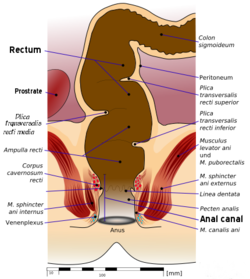Rectally
| Human rectum | |
|---|---|

Drawing of colon seen from front
(rectum coloured red) |
|

Anatomy of the anus and rectum
|
|
| Details | |
| Precursor | Hindgut |
| Artery | Superior rectal artery (first two-thirds of rectum), middle rectal artery (last third of rectum) |
| Vein | Superior rectal veins, middle rectal veins |
| Nerve | Inferior anal nerves, inferior mesenteric ganglia |
| Lymph | Inferior mesenteric lymph nodes, pararectal lymph nodes, internal iliac lymph nodes, Deep inguinal lymph nodes |
| Identifiers | |
| Latin | Rectum |
| MeSH | A03.556.124.526.767 |
| TA | A05.7.04.001 |
| FMA | 14544 |
|
Anatomical terminology
[]
|
|
The rectum (from the Latin , meaning straight intestine) is the final straight portion of the large intestine in some mammals, and the gut in others. The human rectum is about 12 centimetres (4.7 in) long, and begins at the rectosigmoid junction (the end of the sigmoid colon), at the level of the third sacral vertebra or the sacral promontory depending upon what definition is used. Its caliber is similar to that of the sigmoid colon at its commencement, but it is dilated near its termination, forming the rectal ampulla. It terminates at the level of the anorectal ring (the level of the puborectalis sling) or the dentate line, again depending upon which definition is used. In humans, the rectum is followed by the anal canal, before the gastrointestinal tract terminates at the anal verge.
The rectum is a component of the lower gastrointestinal tract. The rectum is a continuation of the sigmoid colon, and connects to the anus. The rectum follows the shape of the sacrum, and ends in an expanded section called the rectal ampulla where feces are stored before their release via the anal canal. An ampulla is a cavity, or the dilated end of a duct, shaped like a Roman ampulla.
Unlike other portions of the colon, the rectum does not have taeniae coli.
The rectum connects with the sigmoid colon at the level of S3, and connects with the anal canal as it passes through the pelvic floor muscles.
Supports of the rectum include:
...
Wikipedia
